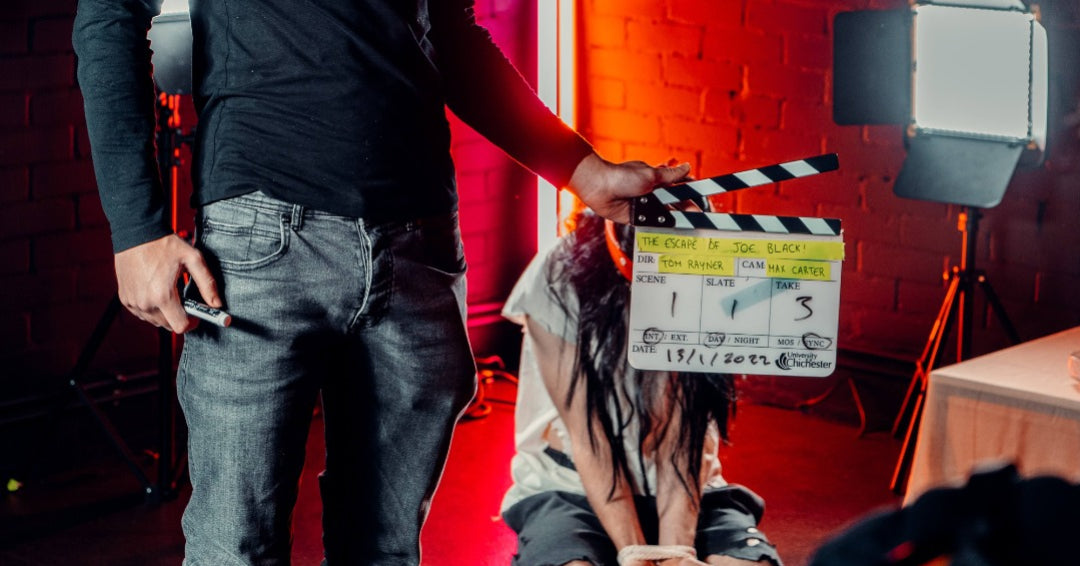
How to use a clapperboard - A simple guide
In the world of film production, one of the foundational tools you'll encounter is the clapperboard. Although it appears basic, its purpose is indispensable. This tool is key for maintaining organisation during production and aids in synchronising audio and visuals during post-production. If you're a professional stepping into the industry, understanding the clapperboard and its components is a necessity.
The Functionality of a Clapperboard
The clapperboard is an essential tool for film production that accomplishes two critical tasks: it helps synchronise sound and picture during editing, and it assists in identifying and organising different scenes and takes during the filming process.
Decoding the Clapperboard
Every piece of information on a clapperboard is recorded with precision. You get various layouts and contents on a board. You may been to add info sections if they are requires. Or if you are on larger productions they may opt for a custom clapperboard where you can design it with the section you require. Each term or figure signifies a distinct aspect of the production process:
-
Production Title: The name of the current production or film.
-
Roll: This designates the camera roll number, an identification method that remains useful even in the age of digital filming. It no longer refers to the roll of film but now refers to the memory card.
-
Scene: The scene number corresponds to a specific section of the film being captured. Filming often occurs out of sequence, making this reference crucial.
-
Slate: A unique identifier for each camera setup.
-
Take: This term is used to denote each separate recording of a particular scene.
-
DIR: The Director’s name.
-
DOP: Director of Photography, who is in charge of the visual aspects of the film.
-
Date: The date of the shoot.
-
SYNC/MOS: This element communicates whether the scene is being filmed with synchronised sound (SYNC) or 'Mit Out Sound' (MOS).
-
INT/EXT: This term indicates the location of the scene, whether it's indoors (INT) or outdoors (EXT).
-
FPS: An abbreviation for Frames Per Second, which indicates the number of individual frames displayed in a video every second.
Slate System
In the UK, the slate system follows a clear sequence. Each new shot or camera setup receives a sequential slate number. These keep going up regardless to the scene. They normally start again at the beginning of a new block (if you are on something running that long).
Utilising the Clapperboard
So lets talk through a typical scenario. Imagine you're working on a production titled "The Last Cookie". So you need to fill in the board first. The filled-out clapperboard might look like this:
Title: THE LAST COOKIE Roll: 1 Scene: 2A Slate: 3 Take: 2, DIR: Sam Smith, DOP: Joe Bloggs, Date: 14/07/23, SYNC, INT, FPS: 25
You need to position yourself in frame, checking with the focus/operator you are in shot. Then the first AD will first call ‘turnover’, then the sound recordist will say ‘sound’s is at speed’. You would announce "Slate 3, Take 2!" followed by a sharp clap of the board, then quickly leaving the scene.
Note: If you are super close to an actor, such as a close up of their face, you will likely want to do a 'soft sticks' so it doesn't affect them. It may be more suitable to do an 'end board' .
In certain circumstances you may be asked to do an 'end board', where you don't mark the shot before the take, but at the end of it. When cut is called, move in, hold the board upside down and clap it, then flip the correct way up and call the slate and take.
Top tip: Always keep the board on you ready to go, carrying it on your belt by putting the top part of sticks through it. You don't want to sit the board down and lose it!
Additional Clapperboard Terminology
- Filter: Denotes the specific type of lens filter used on the camera. eg ND0.3
- VFX: A note indicating that a scene will require Visual Effects during post-production.
- AFS: After false start, (definitely not "Another Flippin' Shot")
- P/U: An abbreviation for Pick-Up, used to mark a shot taken after principal photography has ended.
The Necessity of a Clapperboard
While the clapperboard is a fixture in large-scale film shoots, its use is not always required. For smaller, more compact projects, it may be feasible to use simpler methods like a hand clap for audio synchronisation and digital logs for shot information. However, the importance of the clapperboard as an organising and synchronising tool in professional film settings remains undisputed.
In summary, the clapperboard may seem modest, but it holds a vital position in film production. Its role in maintaining order and facilitating post-production work makes it an indispensable tool for any professional in the industry. Familiarity with the clapperboard and its components is fundamental as you delve deeper into your film production career.
Photo Credit: Ben Collins



Leave a comment